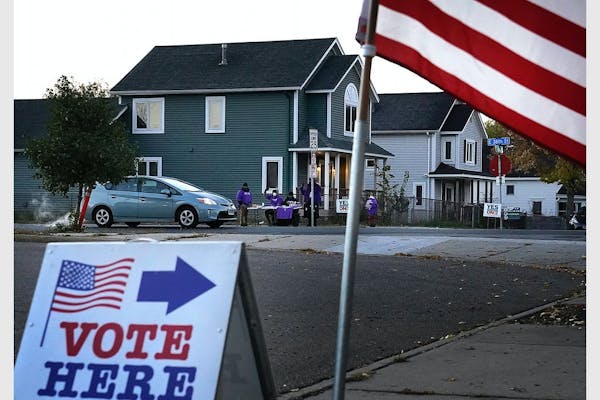The largely Black North Side neighborhoods hit hardest by violent crime and the city's whitest and safest neighborhoods delivered the votes that defeated a nationally watched ballot question seeking to replace the Minneapolis Police Department.
Outside Franklin Middle School on Tuesday in the city's Near North neighborhood, Thomas Kieser said he was voting against the proposal because he feared it would send a message to criminals that police wouldn't respond to emergencies.
"We need the police. Plain and simple," said Kieser, whose neighborhood and surrounding areas lead Minneapolis in gunfire reports. Adding more services to respond to crises would be fine, Kieser said, but "not replacing them, because who's going to protect those people when they go out?"
His remarks echoed a refrain from opponents who blasted voters with fliers and online ads warning that there wasn't a solid plan for replacing the department. Supporters quickly accused them of fearmongering, saying the foundation for building a new, transformative system had already been laid and that it would include police officers.
Through impassioned debates in the nearly 18 months since George Floyd's killing by police, one question was frequently asked: Who would decide the future of policing in Minneapolis? Black residents disproportionately impacted by crime and police use of force, or white voters who often dominate local election turnout?
Precinct-level data showed the concentration of no votes was heaviest in some of the city's western neighborhoods, stretching from Fulton to Bryn Mawr.
Precincts in the city's southwestern corner, among its least racially diverse, leaned heaviest toward the opposition. Those swaths of the city also had some of the lowest crime rates and fewest incidents of police use of force, according to police data.
Farther north was Dee Straub, who cast a no vote in Harrison. "We've got to have police. They're what keeps law and order around here," she said. "I sleep better at night knowing there's police."
The highest number of no votes came from a riverfront precinct in downtown Minneapolis. Older residents who live downtown were drawn to presentations organized by neighborhood groups about the policing amendment, said Steve Cramer, president and CEO of the Minneapolis Downtown Council.
"While crime downtown has trended below crime in other parts of the city, it has been a serious concern for the last 18 months," he said.
Though not definitive, the data did hint at some generational divides.
Ultimately, the proponents found their greatest support in neighborhoods with younger populations, including the areas surrounding the University of Minnesota campus.
The precinct that produced the highest number of yes votes sits in Powderhorn, not far from the intersection of 38th and Chicago where Floyd was killed.
The spot became a gathering place for people who wanted to peacefully pay homage to Floyd — and the site of a dramatic increase in gunfire.
The gap between the yes and no votes was somewhat slimmer in north-central and northwest Minneapolis, where groups seeking to sway voters intensely focused some of their efforts.
Opponents hoped to court voters who wanted reform but also wanted a guarantee of police staffing as they try to curb one of the worst violent crime waves in decades. Supporters hoped to get votes from people who believed the current crises were proof that it was time for a dramatic change.
Both messages resonated. Back at Franklin Middle School on Tuesday, Dionna Jones was voting yes because it was important to have protection but the status quo wasn't working.
"I'm not convinced on either end," Jones said. "Yet, I feel like we have to do something to make real change. … I'm for making an uncomfortable change for something that could potentially be better for our lives."
Ultimately, the opposition was strong in areas like Near North and Camden, which have some of the largest Black communities in Minneapolis, and where the rates of both crime and police use of force were higher than elsewhere in the city.
Nearly every precinct in these areas voted the question down.
The campaigns on both sides brought in millions of dollars as money flowed in from across the country. Yes 4 Minneapolis, the group that wrote the proposal, raised nearly $1.5 million over three months, bringing its annual fundraising total to just shy of $2.5 million before the vote.
Among the groups that led the opposition was All of Mpls, a political committee that brought in nearly $1.6 million, and focused some of its efforts on the North Side.
Leili Fatehi, the group's campaign manager, said in a statement Wednesday: "Minneapolis voters have made clear that they want a planful approach to transforming policing and public safety in our city that includes meaningful consultation with the communities most impacted by violence and over-policing, and a real conversation about how to ensure every resident is protected from crime and from police brutality."
Staff writers Matt Gillmer and Mark Vancleave contributed to this report.
Liz Navratil • 612-673-4994
Jeff Hargarten • 612-673-4642
Michael Corey • michael.corey@startribune.com

Want to share info with the Star Tribune? How to do it securely

'Safe recovery sites' would offer syringes, naloxone and more to people using drugs. The plan could be in peril.
New Minnesota GOP leaders seek peace with party's anti-establishment wing

Who is Republican Lisa Demuth, Minnesota's first House speaker of color?

